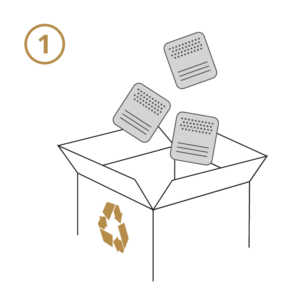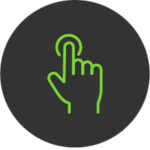
X-Ray Waste Disposal & Recycling
Chemgon® & Foilgon®
Reduce hazardous waste disposal costs by 70%
“Traditional” hazardous x-ray waste collection and disposal companies charge $250-300 to dispose of 5-gallons.* Replace expensive and inefficient waste pick-up services. Using Chemgon, the cost is only $75 to store, treat and dispose of 5-gallons.
Use Foilgon to recycle lead foil and follow the recommendations of the American Dental Association (ADA) Council of Scientific Affairs for proper management of lead foil.
How Chemgon Works

Fill
Fill with equal amounts of Fixer and Developer.
Patented mixture in container solidifies, encapsulates, chelates, absorbs and binds the liquid waste. Let the container sit over night, liquid waste is converted into non-hazardous solid waste.

Trash
Once solidified, throw in your regular trash. It’s that easy!
Effective and Reduced Disposal Costs
Our patented, in-office treatment product safely converts hazardous photo processing chemicals, including Fixer and Developer or Stabilizer and Activator, into a non-hazardous solid waste, safe for disposal in your regular trash. When used correctly, hazardous processing chemicals never leave your office.
Independent testing, including Toxicity Characteristic Leaching Procedures (TCLP), has demonstrated used x-ray processing fluids, photo processing fluids, and graphic arts chemicals treated with Chemgon are below the threshold of hazardous waste.

Frequently Asked Questions about Chemgon
- What is Chemgon?

Chemgon is a patented formula that converts hazardous, silver-laden x-ray and photo processing fluids into a non-hazardous solid, safe for disposal with regular trash.
- How does Chemgon work?
Chemgon solidifies, encapsulates, chelates, absorbs and binds processing chemicals through the application of coordination chemistry, converting your hazardous liquid waste into a non-hazardous solid waste safe for regular trash disposal. Standard toxicity testing (Toxicity Characteristic Leaching Procedure, TCLP) demonstrates that waste treated with Chemgon test below the regulatory levels established by the EPA. Chemgon treated waste results in a nonhazardous, non-biodegradable solid waste, safe for regular trash disposal.
- How do I use Chemgon?
Simply pour equal amounts of fixer and developer into the Chemgon container. Because the patented polymer is highly absorbent, the container may be filled a little at a time over many months. This means it is not necessary to stage or store chemicals separately. Once full, tighten the lid and place in your regular trash. Equal parts of fixer and developer are needed to create a neutral pH; a neutral pH is required for proper treatment and solidification to occur.
Watch our Easy Product Tutorial for Chemgon.
- What are the benefits of using Chemgon?
- Save up to 75% compared to a hazardous waste collection company.
- More convenient than hazardous waste pick-up or silver recovery; simply fill over time and dispose of the solidified contents when full.
- Order from your supply partner and eliminate a separate vendor, contracts, extra invoices and unnecessary interruptions for waste collection.
- What products are not for use with Chemgon?Electrostatic chemistries, fountain solutions, etches and blanket washes should not be used with the Chemgon product.
- I understand equal parts fixer and developer must be added to Chemgon. We only have fixer, what should we do?Purchase new developer to mix with your spent fixer. Pour equal amounts of the “new” developer and spent fixer into the Chemgon container. While we prefer not “wasting” new developer, this approach is less expensive and better for the environment than using a waste collection company.
- Do I need to treat my fixer or photographic chemistry before disposal?YES. The concentration of silver in used photo-processing chemicals is typically between 160-350 Parts per Million (PPM). Mixing with developer reduces the silver PPM by nearly half, between 80 – 175 PPM. The Federal EPA Hazardous Waste RCRA Regulations define hazardous amounts of silver as greater than 5 PPM. This means used, untreated processing chemicals are hazardous. Spent processing waste treated with Chemgon® reduces the PPM below the regulatory limit of 5 PPM and converts it from a liquid to a “solid” non-pourable, non-hazardous waste, safe for regular trash disposal. See EPA Document Table 1. Fines for improper disposal could be as much as $22,000 PER OCCURRENCE. In other words, each time silver-laden processing chemicals or silver reclamation unit liquid residue wastes are poured down the drain, the fine could cost you $22,000.
- Can Chemgon be used in all states?Yes, Chemgon can be used in all 50 states. California is the only state we are aware of that requires Small Quantity Generators to obtain a hazardous waste treatment permit to treat silver-laden photo-processing waste, with Chemgon.
- How do I get a hazardous waste treatment permit in California?To apply for a hazardous waste treatment permit or ‘Standardized Permit’ to treat hazardous silver fixer/activator waste in your office using Chemgon, generators located in California should visit the California Certified Unified Program Agency (CUPA) directory here: https://cersapps.calepa.ca.gov/Public/Directory/. Once there, click on County to find the contact for your area. Contact your county CUPA and ask for the hazardous waste specialist responsible for generator authorization for onsite treatment of this hazardous waste.
- What testing has been done to verify the effectiveness of Chemgon?Representative photo-processing/x-ray waste treated with Chemgon is converted to a non-hazardous solid waste when measured using the following tests: Toxicity Characteristic Leaching Procedure (TCLP) for metals, Paint Filter and the California 96-Hour Acute Aquatic Toxicity test (“Fish Test”).
- How many Chemgon containers can I fill each month and still be considered a Small Quantity Generator (SQG)?In order to be considered an SQG, you must not generate more than 220 lbs. of waste each month. Therefore, you can fill ten (10) Chemgon containers each month. Fixer weighs about (8) lbs. per gallon, so (25) gallons of fixer is the approximate threshold. Since fixer is mixed in equal parts with developer (non hazardous liquid waste) you can utilize (10) Chemgon containers for a total of 50 gallons of fixer/developer each month and still be considered an SQG. Small Quantity Generators are usually exempt from obtaining a treatment permit.
- What is general or acceptable knowledge?Acceptable knowledge is broadly defined to mean an understanding of the resulting hazardous characteristic of the waste in light of the materials used and/or the treatment process used, including film processing waste test results post-treatment. Knowledge of the hazardous characteristic of film processing waste post-treatment can include detailed information about the waste obtained from existing or documented waste treatment analysis and/or studies conducted on wastes generated by processes similar to that which generated the waste in question. This means your “Acceptable Knowledge” includes TCLP toxicity test results provided by the manufacturer for the treatment product used. Click here for toxicity testing results of film processing waste treated using Chemgon: TCLP Reference: 40 CFR 262.11 (c)(2)
- Who is responsible for the "Determination of Hazardous Waste"?The generator is responsible for "determination of hazardous waste," meaning they decided whether their waste is hazardous or non-hazardous. (See Code of Federal Regulations Title 40 CFR 262.11) Federal Regulations allow generators to make that determination by either testing via Toxicity Characterization Leachate Procedure (TCLP); or applying knowledge of the hazard characteristic in light of the materials and/or the processes used. This means you have the option to use documented waste analysis results of treatment, such as our testing results . Click here for Federal Regulations regarding maximum allowable concentration for silver in TCLP results: 40 CFR 261.24 Toxicity Results Table 1
- Where can I get a Chemgon SDS (Safety Data Sheet)?You can find the Chemgon SDS (Safety Data Sheet) here.
How Foilgon Works

Fill
You can fill with lead foil.

Package
Once the container is full, package and attach Pre-paid UPS label.

Ship
Give to your UPS delivery driver. It’s that easy!
Lead Foil is a Hazardous Waste
Federal Regulations prohibit the disposal of lead foil in the trash. It is a hazardous waste unless it is recycled. Federal regulations allow for lead foil to be recycled at licensed facilities. Foilgon has everything you need to collect, ship and recycle lead foil from x-ray film

Available Sizes

Product Sizes & Specs
Chemgon
Most Popular Size: Chemgon 2.5
Size: 2.5 Gallons
Dimensions: 8.57″w x 14.75″h x 6.25″d
Chemgon 5
Size: 5 Gallons
Dimensions: 9.75″w x 15.5″h x 9.75″d
Foilgon
Size: 7 lb capacity
Dimensions: 5.5″w x 7.5″h x 5.5″d
Frequently Asked Questions about Foilgon
- What is Foilgon?

Foilgon is our lead foil recycling product. Lead foil from exposed x-ray film is hazardous and cannot be thrown in the regular trash.
With Foilgon, you get everything you need to properly manage lead waste.
- How does Foilgon work?
- How do I use Foilgon?
Simply order Foilgon from your supply company, or order from us and we'll pass it to your Supply Rep. Open the box and follow directions on inside lid of the box. Place your lead foil in the Foilgon container (no more than 7lbs. per Foilgon container). When Foilgon is full, simply attach prepaid UPS return shipping label to the side of the box and give the entire container to your UPS driver. The container will be delivered to our recycling facility.
- Can we use Foilgon to recycle lead aprons?Because lead aprons include other materials, they may not be recycled using Foilgon. Please check with your lead apron supplier or manufacturer for recycling options.
The Leading Disposal of Lead Foil and Photo Processing Chemicals
Replace your expensive waste pick-up company with Chemgon X-Ray Chemical Disposal, and Foilgon Lead Foil Recycling products.







